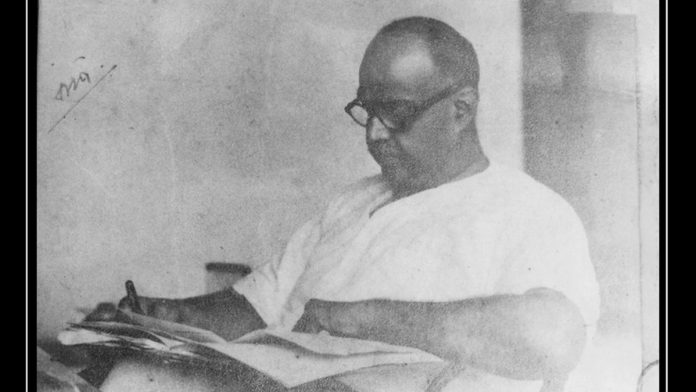By next year, the 125th birth anniversary of Dr. Syama Prasad Mookerjee and the 75th foundation anniversary of the Bharatiya Jana Sangh (BJS) will be observed. Both the life of Dr. Mookerjee and the Jana Sangh travelled together as railway lines. Dr. Mookerjee was an intellect, a scholar, and a thinker, who became the youngest Vice-Chancellor of the University of Calcutta at the age of 33. The Bharatiya Jana Sangh, which he founded on 21st October 1951, has a glorious history, that will be remembered as the first indigenous alternative thought, experiment, and success in Indian politics.
In 1947, Dr. Syama Prasad Mookerjee joined Prime Minister Jawaharlal Nehru’s first cabinet of free India at the young age of 46. It was an Interim National Government prior to the first General election, in which Dr. Mookerjee represented the Hindu Mahasabha and handled the important Ministry of Industries & Supplies. Later, he resigned from the cabinet on April 8, 1950, over disagreements with PM Nehru regarding his pact with Pakistani PM Liaquat Ali Khan, the handling of Kashmir affairs and the plight of Hindus in East Bengal.
The Vision: Though Dr. Mookerjee was initially focused on finding a solution for the eastern part of India, he realized that the issue was much wider and more deeply rooted. Hence, he envisaged finding a political solution for this long term struggle. Dr. Mookerjee, by that time, had quit the Hindu Mahasabha and was party-less. To accomplish his mission, he contemplated starting a new political party. In this regard, he deliberated with the Rashtriya Swayamsevak Sangh (RSS) about the new political party and its modalities. Dr. Mookerjee wanted the RSS to play an active role in his new party. At that time, there was a split opinion within the RSS on whether to accept the proposal, as it did not directly involve itself in political activities. However, there was a necessity not only to protect Bharatiya social and cultural values, but also to create an alternative political & economic model. In this larger national interest, Guruji M.S.Golwalkar, who was the then Sarsangachalak of the RSS, decided to permit its committed cadres to co-operate with Dr. Mookerjee in formation of the new party.
Road Map: Dr. Mookerjee had clear objectives for the role of his new party. On May 5, 1951, in Calcutta, he announced an eight-point charter program, which later became the guiding principles of the BJS.
• United Bharat
• Reciprocity instead of appeasement towards Pakistan
• An independent Foreign Policy that prioritizes Bharat’s self Interest
• Rehabilitation of refugees with suitable compensation from Pakistan
• Increased production and decentralization of industry
• Development of a single Bharatiya Culture
• Equal rights for all citizens regardless of caste, community, or creed along with improving the standard of the backward classes.
• Readjustment of the border of West Bengal with Bihar
Prop Roots: Though the proposed party was initially started at a regional level, it gradually began to assume a national outlook. Soon it began to establish strong regional units, like prop roots supporting a banyan tree. On May 27, 1951, the Delhi unit of the Jana Sangh was formed with Balraj Bhalla elected as president and Balraj Madhok as secretary. They coordinated with members from other provinces, including Punjab and Himachal Pradesh to set up its branches. On September 2, in Lucknow, the Uttar Pradesh unit was formed with Rao Krishana Pal Singh as president and Pt. Deendayal Upadhyay as secretary. On the same day, at Indore, Madhya Bharat & Bhopal units were inaugurated with Badrilal Dave as president and Manoharrao Moghe as secretary. During September, the Karnataka unit was formed under the presidency of G. Paramasiviah, former Mysore High Court Justice. On October 13, the Rajasthan – Ajmer Jana Sangh was inaugurated with Chiranjilal Mishra as president and Sundersingh Bhandari as one of the two secretaries. During the same period, the Vindhya Pradesh unit was formed in Satna, and the Patna unit was formed in Bihar. Later, the Ahmedabad & Assam units of the Jana Sangh were established.
Foundation: On October 21,1951, in a meeting held in Delhi, the Bharatiya Jana Sangh (BJS) was officially declared a National Party, and Dr. Syama Prasad Mookerjee was elected its President. The BJS claimed credit as a national party started post-independence by an Indian unlike the Congress or Communist parties, and subscribing to an Indian Ideology. To assist him, Dr. Mookerjee appointed both Mauli Chandra Sharma and Bhai Mahavir as general secretaries of the party. He later appointed Atal Bihari Vajpayee as his private secretary, who would go on to become the Prime Minister in 1996.
Lighting of the Lamp: As a newborn party, BJS had little time to prepare for the general elections. Though RSS was the primary source of strength for the party, it attracted people from diverse levels of society including politicians from other parties, legal luminaries, and small businessmen. The party manifesto was released in Delhi on October 29, 1951, in line with the pattern designed by KR Malkani. To contest the 1952 elections, the BJS only expected two qualities from its candidates – one, that they should finance their own election; and two, they should subscribe to the manifesto of the party. Unlike other national parties like the Congress, the BJS was not privileged with funds, narratives, or well-known personalities. However, in the Lok Sabha elections, it secured about 3.06% of the votes and 3 seats – Dr. Mookerjee himself from Calcutta Southeast, Durga Charan Banerjee from Medinipur (both from West Bengal), and Umashankar Muljibhai Trivedi from Chittor, Rajasthan. In the Assemblies, the BJS won 35 seats with 2.76% of the votes. It had its representatives elected from Delhi, Rajasthan, Madhya Bharat, Vindhya Pradesh, the Punjab region, Uttar Pradesh and West Bengal. The Election Commission had set a threshold of 3% of the total popular vote to qualify as a national party. Since the BJS achieved this, it was recognized as a national party and was allotted the Pradip (Lamp) symbol for exclusive use by its candidates.
The Resolve: In Parliament, despite having minimal representation, Dr. Mookerjee emerged as an experienced opposition leader and an axis for other opposition parties. He spearheaded a political platform – the National Democratic Party (NDP) comprising parties other than the BJS such as the Akali Dal, Hindu Mahasabha, Tamilnad Toilers Party, Ganatantra Parishad, and other smaller parties. The party held its first annual session from December 29 to 31, 1952, in Kanpur organized by Nanaji Deshmukh, who was then the organizing secretary of the Uttar Pradesh unit. In the session, Pt. Deendayal Upadhyaya replaced Bhai Mahavir as the general secretary. Moreover, the NDP constituents were also invited to take part in the session, wherein the Ganatantra Parishad declared its merger with the BJS. Issues related to East Pakistan and Kashmir were discussed in detail during the session. The Jana Sangh took a strong and clear stand on Jammu & Kashmir issues. When Art.370 granting special status to the state of Jammu & Kashmir (J&K), was inserted into the Constitution in Nov 1951, the RSS and the Jana Sangh strongly opposed the move and raised a famous war cry – Ek desh mein do vidhan, do nishan, aur do pradhan nahin chalenge (In one country, two constitutions, two flags, and two prime ministers will not be tolerated).
Pradip becomes Pole Star: Dr. Mookerjee joined the movement against the policy mandating identity cards for those settling in the state of J&K. He led a protest from Delhi, passing through Punjab, and after crossing the Ravi river at Madhopur, was arrested on May 11, 1953, by the J&K Government. While in custody, Dr. Mookerjee fell ill and passed away on June 23, 1953. The Jana Sangh felt orphaned by the demise of its founder president, especially at such an early stage of the party’s inception. Without Dr. Mookerjee, there was no thread to hold the political platform NDP together. However, as a party committed to ideology and with strong cadre support, the BJS revived itself from the leadership vacuum, and began to march ahead.
The BJS successfully increased its vote share in each passing Lok Sabha elections. Its ideological position for the withdrawal of special status to J&K became a reality when its political successor the Bharatiya Janata Party (BJP), led by Narendra Modi, assumed office as Prime Minister. In his successive second term in office, the Modi Government successfully abrogated Art.370 through a Presential Order on 05 August 2019 and got it ratified both by the Parliament and later by the Supreme Court of India.
Later many strong personalities came forward to offer leadership and guide the party, including like Debaprasad Ghosh, Balraj Madhok, Pt. Deendayal Upadhyay, Atal Bihari Vajpayee and Lal Krishna Advani (which will be discussed in detail in the next part).
(The views expressed are the author's own and do not necessarily reflect the position of the organisation)



